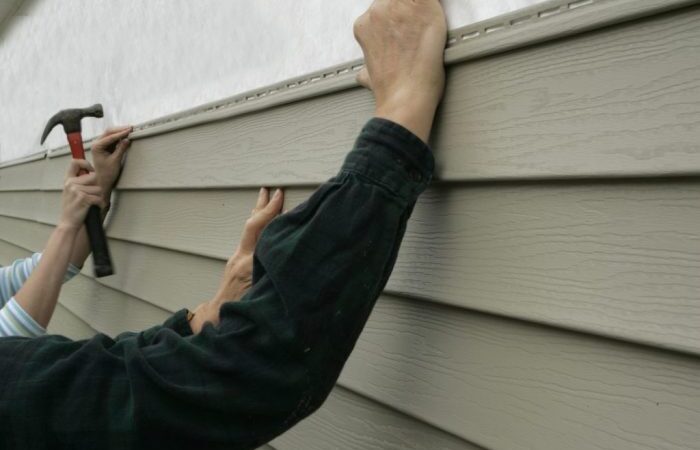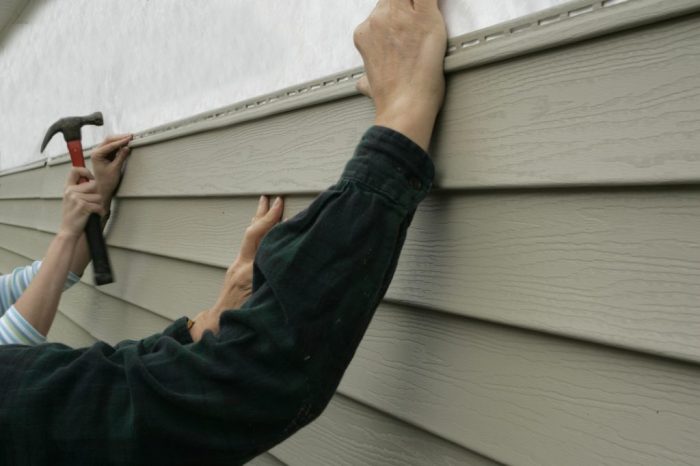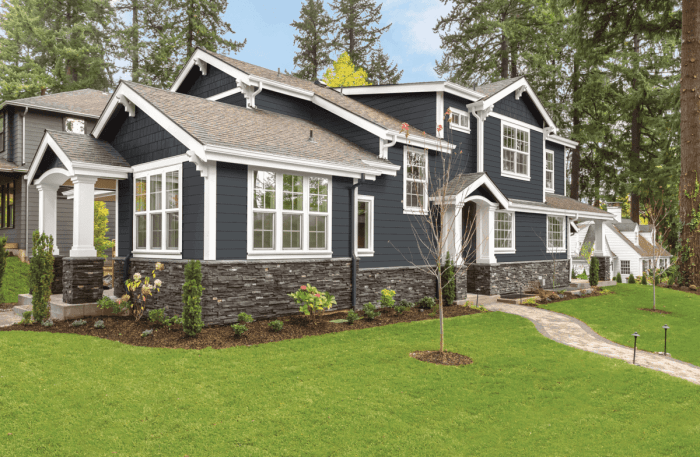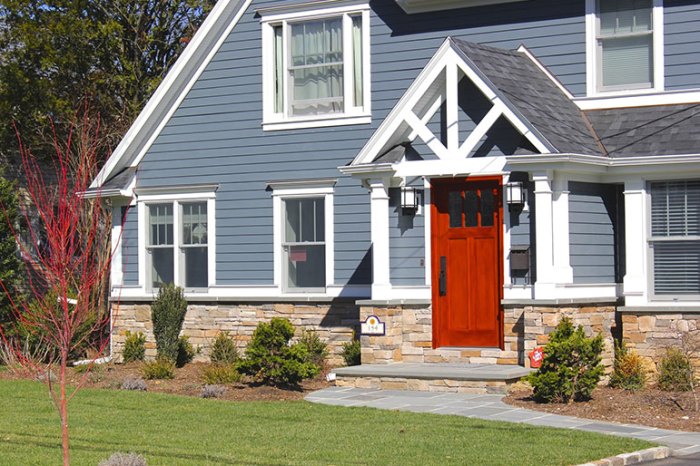New Siding for House A Complete Guide

New siding for house – New siding for your house is a big decision, impacting both your home’s curb appeal and its long-term health. This guide dives deep into everything you need to know, from choosing the right material to understanding the installation process and budgeting for the project. We’ll explore various siding options – vinyl, wood, fiber cement, metal, and engineered wood – comparing their lifespans, maintenance needs, costs, and aesthetic qualities. Get ready to transform your home’s exterior!
We’ll walk you through the step-by-step installation process, from prepping your home’s exterior to the final touches. You’ll find helpful tips on choosing siding that complements your home’s style and climate, and we’ll even cover the environmental impact of different materials. By the end, you’ll be equipped to make informed decisions and confidently tackle your siding project.
Types of House Siding

Source: ebyexteriors.com
Choosing the right siding for your house is a big decision, that impacts both the look and the longevity of your home. This section will explore the most popular siding materials, comparing their lifespans, maintenance needs, costs, and aesthetic qualities to help you make an informed choice.
Siding Material Comparison
Different siding materials offer a variety of benefits and drawbacks. Understanding these differences is crucial for selecting the best option for your home and budget. We’ll focus on four common types: vinyl, wood, fiber cement, and metal.
| Siding Material | Lifespan (Years) | Maintenance | Cost (per sq ft) |
|---|---|---|---|
| Vinyl | 20-40 | Low; occasional cleaning | $3-$10 |
| Wood | 20-50+ (depending on wood type and maintenance) | High; regular painting, staining, and potential repairs | $6-$20+ |
| Fiber Cement | 30-50+ | Moderate; occasional cleaning, repainting every 10-15 years | $8-$15 |
| Metal | 40-75+ | Low; occasional cleaning | $7-$20+ |
Aesthetic Qualities and Architectural Styles
The aesthetic appeal of siding is a significant factor in the decision-making process. Each material offers a unique look and feel, lending itself to different architectural styles.
Vinyl siding comes in a vast array of colors and textures, mimicking the appearance of wood, stone, or brick. Its versatility makes it suitable for a wide range of styles, from traditional to contemporary. Imagine a charming Cape Cod cottage with crisp white vinyl siding, or a modern ranch house with sleek gray vinyl.
Wood siding, particularly cedar or redwood, offers a natural, warm aesthetic. Its rich textures and grain patterns create a timeless look, particularly well-suited for traditional, rustic, or craftsman-style homes. Picture a stately Victorian home with intricately detailed cedar shingles, or a cozy cabin with rustic clapboard siding.
Fiber cement siding provides a clean, sophisticated look that can mimic the appearance of wood or stucco. Its durability and versatility make it a popular choice for a variety of architectural styles, from modern to traditional. Consider a contemporary home with smooth, gray fiber cement siding, or a farmhouse with textured fiber cement siding that resembles wood planks.
Metal siding, often aluminum or steel, offers a modern, industrial aesthetic. It’s available in various colors and finishes, and its durability makes it a popular choice for homes in harsh climates. A sleek, metallic finish would complement a modern or industrial-style home. Conversely, a darker, textured metal siding could add a rustic touch to a farmhouse.
Siding Installation Process
Getting new siding is a big project, but with careful planning and execution, you can achieve a beautiful and long-lasting result. This section Illustrates the steps involved in a typical siding installation, from preparing your home’s exterior to the final touches. Remember, safety is paramount; always prioritize your safety and follow all manufacturer instructions.
Successful siding installation hinges on thorough preparation. A well-prepared surface ensures proper siding adhesion, prevents future problems, and ultimately leads to a more professional-looking finish. Ignoring this stage can lead to costly mistakes down the line.
House Exterior Preparation
Preparing the house exterior involves several key steps. First, you’ll need to remove any existing siding, carefully noting the underlying structure. This allows for a thorough inspection of the sheathing and any necessary repairs. Next, address any damaged areas of the underlying sheathing or wall framing. This might include replacing rotten wood, repairing damaged areas with patching materials, or reinforcing weak spots. After repairs, ensure the surface is clean, dry, and free of any loose debris. This clean surface is crucial for the proper adhesion of the new siding. Finally, apply a weather-resistant barrier, such as house wrap, to protect the home’s exterior from moisture damage. This step is essential for preventing water intrusion and improving energy efficiency.
Tools and Materials Needed for Siding Installation
Proper tools and materials are essential for a smooth installation process. Having everything readily available will save you time and frustration.
Gathering the necessary materials and tools beforehand is crucial for efficiency and a smooth installation. An organized approach minimizes interruptions and ensures the project stays on schedule.
- Measuring tape and level
- Circular saw or miter saw (depending on siding type)
- Hammer and nail gun (with appropriate nails for siding type)
- Safety glasses and work gloves
- Caulk gun and exterior-grade caulk
- Ladder (appropriate height for your home)
- Utility knife
- Siding materials (quantity determined by house dimensions)
- J-channel, starter strip, and other trim pieces (as needed for siding type)
- House wrap or weather barrier
- Flashing (for windows and doors)
Siding Installation Steps
The installation process itself varies depending on the type of siding used. However, some general steps remain consistent across most types. Always consult the manufacturer’s instructions for your specific siding material.
The following steps provide a general overview. Specific details will vary based on the siding type and the complexity of your home’s exterior. Always refer to the manufacturer’s instructions for your chosen siding.
- Install starter strip: This provides a level base for the first row of siding.
- Install J-channel around windows and doors: This creates a clean, finished look and protects these areas from water damage.
- Install the first row of siding: Ensure it is level and properly aligned.
- Install subsequent rows: Overlap each row according to manufacturer instructions, ensuring proper alignment and spacing.
- Cut and install siding around windows and doors: This often requires precise measurements and cuts.
- Install corner trim and other finishing pieces: These add a professional touch and complete the installation.
- Caulk all seams and joints: This seals the siding and prevents water intrusion.
Cost Considerations for New Siding
Replacing your house siding is a significant investment, and understanding the associated costs is crucial for budgeting and planning. This section breaks down the typical expenses involved, helping you estimate the total project cost for your home. Remember that these are averages, and your actual costs may vary depending on several factors.
The overall cost of new siding is determined by a combination of material costs, labor costs, and permit fees. Material costs vary greatly depending on the type of siding chosen (vinyl, wood, fiber cement, etc.), its quality, and the amount needed. Labor costs depend on the complexity of the job, the size of your house, and the contractor’s rates. Permit fees are set by your local government and vary by location.
Average Costs of New Siding Installation
A breakdown of typical costs helps illustrate the range of expenses. These figures are estimates and can change based on location, materials, and project specifics. Always obtain multiple quotes from reputable contractors for accurate pricing in your area.
| Siding Type | Material Cost (per sq ft) | Labor Cost (per sq ft) | Total Cost (per sq ft) |
|---|---|---|---|
| Vinyl | $1-$5 | $2-$5 | $3-$10 |
| Wood | $3-$15 | $4-$8 | $7-$23 |
| Fiber Cement | $4-$12 | $5-$10 | $9-$22 |
| Metal | $6-$15 | $5-$10 | $11-$25 |
Note: These costs exclude permits and potential additional expenses like repairs to underlying sheathing or removal of old siding.
Sample Budget for a Siding Project, New Siding for a house
Let’s create sample budgets for different scenarios to illustrate the cost variations.
| House Size (sq ft) | Siding Type | Material Cost | Labor Cost | Permit Fees (Estimate) | Total Estimated Cost |
|---|---|---|---|---|---|
| 1500 sq ft | Vinyl | $1500 – $7500 | $3000 – $7500 | $500 | $4500 – $15500 |
| 2500 sq ft | Fiber Cement | $10000 – $30000 | $12500 – $25000 | $750 | $23250 – $55750 |
| 1000 sq ft | Wood | $3000 – $15000 | $4000 – $8000 | $300 | $7300 – $23300 |
These are just examples, and actual costs will vary. A 1500 sq ft house with vinyl siding might cost less than $15,500 if you choose a less expensive vinyl and find a contractor with competitive rates. Conversely, a more luxurious fiber cement siding on a larger home could exceed the higher estimates provided.
Factors Influencing Siding Project Costs
Several factors beyond material and labor can impact the final cost. Understanding these factors allows for better budgeting and realistic expectations.
- House size and complexity: Larger houses and those with intricate designs require more materials and labor, increasing costs.
- Existing siding condition: Removing old, damaged siding adds to labor costs. Extensive repairs to underlying sheathing further inflate the budget.
- Siding quality and features: Higher-quality materials with advanced features (e.g., thicker vinyl, specialized wood treatments) command higher prices.
- Contractor’s experience and reputation: Experienced, reputable contractors often charge more but may provide better quality workmanship and warranties.
- Geographic location: Labor and material costs vary regionally, affecting the overall project expense.
- Permitting fees and inspections: Local government fees and inspection costs can add several hundred dollars to the total.
- Hidden problems: Unexpected issues discovered during installation (e.g., rotted wood, insect infestation) can increase costs significantly.
Maintenance and Repair of House Siding: New Siding For House
Proper maintenance is crucial for extending the life and beauty of your house siding. Neglecting upkeep can lead to costly repairs down the line, so understanding your siding type and its specific needs is essential. This section will cover common issues, cleaning methods, and a recommended maintenance schedule for various siding materials.
Common Siding Issues and Solutions
Different siding materials face unique challenges. Wood siding, for example, is susceptible to rot and insect infestation, while vinyl siding can crack or fade in harsh sunlight. Aluminum siding is prone to dents and scratches, and fiber cement siding can chip or crack if impacted. Addressing these issues promptly prevents further damage.
- Wood Siding: Rot and insect damage often require replacing affected sections. Regular inspection and prompt treatment with wood preservatives are vital preventative measures. Minor surface damage can sometimes be repaired with wood filler and paint.
- Vinyl Siding: Cracks are usually caused by impact. Minor cracks might be repaired with vinyl patching kits, but severely damaged panels often need replacement. Fading can be mitigated by regular cleaning and the application of a UV protectant.
- Aluminum Siding: Dents can be carefully pushed out from the back, but severe damage usually necessitates panel replacement. Regular cleaning prevents the build-up of dirt and grime, which can accelerate corrosion.
- Fiber Cement Siding: Chips and cracks, especially around edges, can be repaired with patching compounds specifically designed for fiber cement. Larger cracks might require professional attention.
Cleaning and Maintaining Various Siding Materials
Regular cleaning is a cornerstone of siding maintenance. The method varies depending on the material. Always use a gentle approach to avoid damaging the surface.
- Wood Siding: Use a soft brush and a mild detergent solution. Rinse thoroughly with water. Avoid pressure washing, as it can damage the wood. Consider applying a wood sealant every few years to protect against moisture.
- Vinyl Siding: A solution of mild detergent and water, applied with a soft brush or sponge, is usually sufficient. Rinse thoroughly and allow to air dry. A pressure washer can be used with caution, maintaining a safe distance to prevent damage.
- Aluminum Siding: A simple wash with soap and water is generally all that’s needed. Avoid abrasive cleaners, as they can scratch the surface. A pressure washer can be used, but maintain a safe distance.
- Fiber Cement Siding: Clean with a soft brush and a mild detergent solution. Rinse thoroughly with water. Avoid abrasive cleaners and pressure washing, which can damage the surface.
Siding Maintenance Schedule
A regular maintenance schedule ensures early detection and prevention of problems. The frequency of cleaning and inspection depends on your climate and siding type.
| Siding Type | Cleaning Frequency | Inspection Frequency | Other Maintenance |
|---|---|---|---|
| Wood | Twice yearly | Annually | Apply wood preservative every 2-3 years, and repair/replace damaged sections as needed. |
| Vinyl | Twice yearly | Annually | Check for cracks and damage, and replace damaged sections as needed. |
| Aluminum | Once yearly | Annually | Inspect for dents and corrosion, and repair/replace damaged sections as needed. |
| Fiber Cement | Once yearly | Annually | Inspect for chips and cracks, and repair/replace damaged sections as needed. |
Choosing the Right Siding for Your Home

Source: woodbridgehomesolutions.com
Picking the perfect siding for your house involves more than just aesthetics; it’s a decision that impacts your home’s energy efficiency, longevity, and overall value. Several key factors need careful consideration to ensure you make the right choice for your specific needs and circumstances.
Choosing the right siding requires a balanced approach, weighing factors like climate, budget, home style, energy efficiency, and environmental impact. Ignoring any of these could lead to costly repairs, higher energy bills, or a less aesthetically pleasing result.
Climate Considerations for Siding Selection
Your local climate significantly influences siding material selection. In areas with harsh winters and extreme temperature fluctuations, materials like fiber cement or vinyl siding, known for their durability and resistance to cracking and warping, are excellent choices. Conversely, in milder climates, wood siding might be a suitable option, offering a classic aesthetic. Coastal regions prone to high humidity and salt spray benefit from siding materials resistant to moisture damage, such as vinyl or fiber cement. For areas prone to wildfires, non-combustible materials like stucco or fiber cement are crucial for safety.
Budgetary Implications of Different Siding Materials
Siding costs vary considerably depending on the material, installation complexity, and labor costs. Vinyl siding is generally the most affordable option, offering a balance between cost and durability. Wood siding, while aesthetically pleasing, tends to be more expensive due to material costs and the often-specialized installation required. Fiber cement siding falls somewhere in the middle, providing excellent durability and longevity at a price point higher than vinyl but lower than high-end wood options. Stone or brick siding represents the most expensive option. When budgeting, remember to include not only material costs but also professional installation fees and any potential future maintenance expenses. For example, a 2,000-square-foot home might see vinyl siding costs ranging from $8,000 to $16,000, while fiber cement could range from $15,000 to $30,000, and wood siding even higher.
Energy Efficiency and Siding Material
The energy efficiency of your siding directly impacts your home’s heating and cooling costs. Materials with high R-values (a measure of thermal resistance) help to insulate your home, reducing energy loss. Fiber cement siding, for example, offers better insulation than vinyl, resulting in potential savings on energy bills. Light-colored siding reflects sunlight, reducing heat absorption, especially beneficial in warmer climates. Conversely, darker siding absorbs more heat, potentially increasing cooling costs. Consider the climate and your home’s orientation when evaluating the energy efficiency of different siding materials. For instance, a home in a sunny, hot climate might benefit significantly from a light-colored, highly reflective siding option.
Environmental Impact and Sustainability of Siding Materials
The environmental impact of siding materials varies widely. Vinyl siding, while affordable, is derived from petroleum and is not readily biodegradable. Wood siding, sourced from sustainable forests, can be a more environmentally friendly choice, especially when certified by organizations like the Forest Stewardship Council (FSC). Fiber cement siding, while durable, involves manufacturing processes with potential environmental consequences. Recycled materials used in siding production are gaining popularity, offering a more sustainable approach. When selecting siding, consider the material’s lifecycle, from manufacturing to disposal, and choose options with minimal environmental impact. For example, choosing FSC-certified wood siding supports responsible forestry practices.
Visual Examples of House Siding

Source: ebyexteriors.com
Choosing the right siding can dramatically alter a home’s aesthetic appeal. Let’s explore some examples to illustrate the impact of different siding materials, colors, and textures. We’ll focus on how these choices contribute to the overall architectural style and curb appeal.
Three Houses with Varying Siding Styles
Imagine three distinct houses, each showcasing a unique siding approach. The first is a charming Cape Cod-style home, painted a warm, creamy white with classic clapboard siding. The wood clapboards, neatly aligned, create a sense of timeless elegance. Dark green shutters and a matching front door add a pop of color, complementing the overall traditional aesthetic. The second house is a modern farmhouse, clad in sleek, gray fiber cement siding. This siding provides a clean, contemporary look, contrasting beautifully with the crisp white trim and large, black windows. The texture of the fiber cement is subtle but adds depth to the facade. Finally, we have a Craftsman-style bungalow, featuring a rich, earthy brown wood shingle siding. The varied lengths and slightly irregular patterns of the shingles give the home a rustic, handcrafted feel. The natural wood tones blend harmoniously with the surrounding landscape.
A House with Unique Siding Features
Picture a Victorian-era home, its multi-gabled roofline adorned with a stunning combination of materials. The main body of the house is covered in deep red cedar shingles, weathered to a soft, almost burgundy hue. These shingles are meticulously arranged, emphasizing the home’s intricate architectural details. However, what truly sets this house apart is the contrasting accent siding. The dormers and bay windows are clad in a creamy-white, wide-plank siding, creating a striking visual contrast against the darker shingles. This juxtaposition of textures and colors draws the eye, highlighting the architectural features and creating a truly memorable facade. The elaborate trim work, painted a crisp white, further enhances the overall effect, making the home a showstopper.
Siding Colors and Textures Complementing House Styles
Different siding choices dramatically impact the overall look of a house. A ranch-style home, known for its low profile and horizontal lines, is beautifully complemented by horizontal wood siding in a light, neutral tone like beige or light gray. This emphasizes the home’s horizontal emphasis and creates a feeling of spaciousness. Conversely, a tall, narrow Victorian home benefits from vertical siding, such as clapboard or shiplap, in a darker, richer color such as deep blue or forest green. This verticality draws the eye upwards, balancing the home’s height and emphasizing its vertical lines. A craftsman bungalow, with its emphasis on natural materials and handcrafted details, might be ideally suited to a warm, natural wood shingle siding in tones of brown or reddish-brown, perhaps accented with stonework. The texture of the shingles adds a rustic charm that perfectly complements the architectural style. These examples highlight how careful consideration of color and texture can greatly enhance a home’s aesthetic appeal.
Concluding Remarks
Updating your house siding is a significant investment that can dramatically improve your home’s value and appearance. Remember to carefully consider your budget, climate, architectural style, and desired level of maintenance when selecting a material. By following the steps Artikel in this guide, you can navigate the process with confidence, transforming your home’s exterior into something truly special. Happy siding!
FAQ Section
What’s the average lifespan of different siding materials?
Vinyl siding typically lasts 20-30 years, wood 20-50 years (depending on maintenance), fiber cement 50+ years, and metal 40+ years.
Can I install the siding myself?
While possible for some types, professional installation is generally recommended for a quality, long-lasting result. It also often comes with warranties.
How do I clean my siding?
Cleaning methods vary by material. Generally, a pressure washer (low pressure for softer materials) with soap and water works well. Always check manufacturer recommendations.
What permits do I need?
Building permits are usually required for exterior renovations. Check with your local authorities for specific requirements.
What about insurance?
Check your homeowner’s insurance policy. Some policies may require notification of renovations, and some contractors carry liability insurance.
Comments are closed.